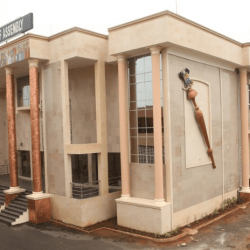The 11 rock-hewn Churches of Lalibela, Ethiopia are:
- Biete Medhani Alem (House of the Saviour of the World)
- Biete Mariam (House of Mary)
- Biete Maskal (House of the Cross)
- Biete Denagel (House of Virgins)
- Biete Golgotha Mikael (House of Golgotha Mikael)
- Biete Amanuel (House of Emmanuel)
- Biete Qeddus Mercoreus (House of St. Mercoreos)
- Biete Abba Libanos (House of Abbot Libanos)
- Biete Gabriel Raphael (House of Gabriel Raphael)
- Biete Lehem (House of Holy Bread)
- Biete Ghiorgis (House of St. George)

There are two main groups of these churches:
(A) To the north of the river Jordan
- Biete Medhani Alem (House of the Saviour of the World)
- Biete Mariam (House of Mary)
- Biete Maskal (House of the Cross)
- Biete Denagel (House of Virgins)
- Biete Golgotha Mikael (House of Golgotha Mikael)
(B) And to the south of the river
- Biete Amanuel (House of Emmanuel)
- Biete Qeddus Mercoreus (House of St. Mercoreos)
- Biete Abba Libanos (House of Abbot Libanos)
- Biete Gabriel Raphael (House of Gabriel Raphael)
- Biete Lehem (House of Holy Bread)
- Biete Ghiorgis (House of St. George)
The eleventh church, Biete Ghiorgis (House of St. George), is isolated from the others, but connected by a system of trenches.
The churches were not constructed in a traditional way but were rather hewn from the rock of monolithic blocks.
These blocks were further chiselled out, forming doors, windows, columns, various floors, roofs etc.
The work was further completed with an extensive system of drainage ditches, trenches and ceremonial passages, some with openings to hermit caves and catacombs.
Biete Medhani Alem, with its five aisles, is believed to be the largest monolithic church in the world, while Biete Ghiorgis has a remarkable cruciform plan. Most were probably used as churches from the outset, but Biete Mercoreos and Biete Gabriel Rafael may formerly have been royal residences. Several of the interiors are decorated with mural paintings.
These exceptional churches have been the focus of pilgrimage for Coptic Christians since the 12th century.
The churches are almost 1,000 years old
Although nobody has been able to figure out an exact construction date on the churches, it’s thought that they were built between the 12th and 13th centuries.

Some scholars believe the churches continued to be built into the 14th century as well.
The town and churches are named after an Ethiopian king, Lalibela
Lalibela town is a mountainous area in Ethiopia, some 645 km from Addis Ababa.
The construction of the rock churches in the place is attributed to King Lalibela who set out to construct in the 12th century a ‘New Jerusalem’, after Muslim tyrants halted Christian pilgrimages to Jerusalem, the holy Land.
The town is named after him. The churches are generally named after him as well.
King Lalibela was considered a recluse earlier in his life, but later became king of Ethiopia, only to become a recluse again.

Lalibela is thought to have built ten of the churches while he was alive.
Following the decline of the Aksumite Empire, the Zagwe Dynasty emerged in the 12th century, ushering in a new era of Ethiopian history.
During this period, the famous rock-hewn churches of Lalibela were constructed, which remain an important pilgrimage site for Ethiopian Orthodox Christians.
These architectural marvels, carved out of solid rock, are concrete evidence of the skill and creativity of Ethiopian artisans.


















